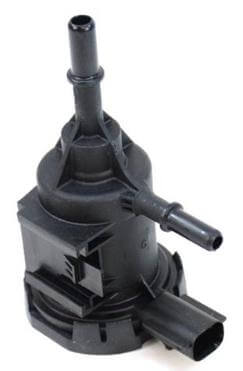Purge valve symptoms
Bad Purge valve symptoms
A purge valve is an important component in the Evaporative Emissions System. If it fails, you’ll notice one or more of the following purge valve symptoms.
Bad purge valve symptoms
Check Engine Light comes on
If the purge valve is not acting as expected, the ECM will set a Check Engine Light because the engine is receive too much fuel vapor or too much air. It will also set one or more of these trouble codes.
P0443 – Evaporative Emission Control System Purge Control Valve Circuit
P0444 – Evaporative Emission Control System Purge Control Valve Circuit Open
P0445 – Evaporative Emission Control System Purge Control Valve Circuit Shorted
P0446 – Evaporative Emission Control System Vent Control Circuit
P0455 – Evaporative Emission Control System Leak Detected (Large Leak)
P0456 – Evaporative Emission Control System Leak Detected (Small Leak)
P0457 – Evaporative Emission System Leak Detected (Fuel Cap Loose/Off)
P1443 – Evaporative Emission Control System Control Valve
A bad purge valve can cause rough idle
If the purge valve is stuck open, it will allow the engine to suck in too much air, causing a rough idle.
A stuck open purge valve can cause hard starting or no start after gas fill-up
The purge valve should be closed as you fill the tank. If it’s stuck open fuel vapor in the gas tank will bypass the charcoal canister and flow directly into the engine, causing it to flood as you fill the tank. That will make it hard to start the engine.
If you’re not filling the tank, a stuck open purge valve can make it hard to start the engine because the valve is allowing too much unmetered air to enter the engine.
Want to diagnose your purge valve failure. See this post
Poor Engine Performance
Even if your vehicle manages to start with a faulty purge valve, the extra air will lower engine performance.
Poor Gas Mileage and Fuel Economy
A stuck closed purge valve will prevent the Evaporative Emssions System from conducting a purge cycle and the charcoal canister will remain filled with fuel vapor. Any additional fuel vapor pressure in the tank will be vented to the atmosphere, thus wasting fuel.
Stuck closed purge valve makes it almost impossible to fill your tank
A stuck closed purge valve will prevent the system from conducting a purge cycle and the charcoal canister will be full. As you fill the tank, the fuel vapors will vent to the atmosphere, creating backpressure that shuts off the fuel nozzle, preventing you from filling your tank.
Collapsed Fuel Tank
A fully open purge valve can sometimes make the fuel tank (gas tank) collapse and deform since the tank is under constant engine vacuum.
Though rare, this can happen if the purge valve is stuck open while the EVAP canister vent valve is shut, creating an excessive vacuum in the EVAP system. This can also trigger the P0457 code for an EVAP leak due to a loose or missing gas cap.
Fuel Smell from the Engine
A stuck open purge valve can allow gas vapors into the engine when the engine is off. So you can notice a fuel smell under the hood even with the engine off.
What is a purge valve
When you fill your car with gas, the fuel vapors are collected
in a charcoal canister. The canister can only hold a certain amount of fuel vapor, so it has to be purged by running fresh air through it so it can be used again on the next fill-up.
After filling up, the ECM commands a purge cycle. During the purge cycle, the purge valve opens, allowing the engine to suck fuel vapors out of the charcoal canister. In addition, the ECM commands a vent valve to open to allow fresh air into the charcoal canister.
How long the purge valve remains open
Since the engine is sucking in fuel-laden vapor, the ECM monitors engine performance cuts back on fuel injector ON time (because the engine is getting fuel vapor form the charcoal canister). As the purge nears completion, the engine receives less fuel vapor and more fresh air from the canister because the canister vent valve it open.
The ECM detects the drop in fuel vapor through the oxygen sensor. It then closes the vent valve while the engine is pulling a vacuum through the purge valve. On some vehicles, a fuel tank pressure valve measure the amount of vacuum in the system and the ECM watches for the vacuum to either hold or deteriorate. If the vacuum goes down, that signifies a leak in the system and it will set an Evaporative Emissions Leak trouble code. If the vacuum holds, the EVAP system passes the test and the purge valve is closed.
©, 2020 Rick Muscoplat

